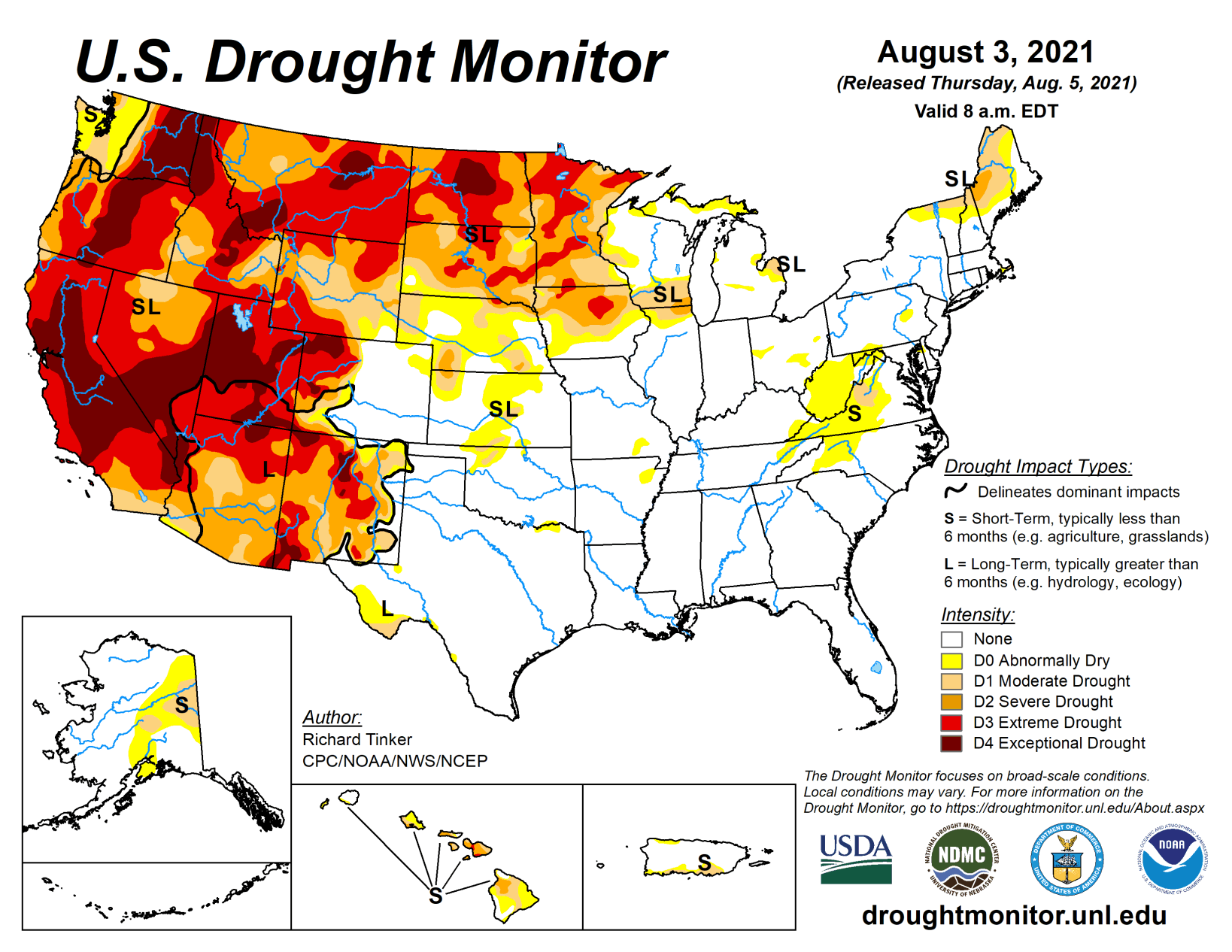Abundant monsoonal precipitation again spread from the Southwest as far as eastern Nevada, southern Idaho, southern and western Wyoming, and western Colorado. Totals exceeding an inch were common, and 2 to 4 inches doused some of the higher elevations, especially across the central Rockies and Intermountain West.
Most other areas of dryness and drought recorded at least light precipitation, but totals were not enough to significantly improve dryness and drought from the Plains eastward. Conditions deteriorated in several areas where there was little or no rainfall, specifically the northern Plains from eastern Montana through western Minnesota, from central Kansas and adjacent Colorado northward into Nebraska, across northeastern Arkansas, over the central Virginias, and in the climatologically dry areas of the Far West.
Temperatures fluctuated during the week, with unusual heat covering central and southeastern parts of the country early in the period, but restricted to near the Gulf Coast by the end of the period. On the other hand, abnormally hot conditions slowly developed in much of the West after a relatively mild start (due in large part to monsoonal rainfall).
South
Scattered patches of dryness can be found in the South, but they are few and far between. One to two months of subnormal rain prompted new, small areas of abnormal dryness (D0) in northeastern Tennessee and part of northeastern Arkansas. The latter area has seen 30 to 65 percent of normal precipitation in the past month. A small new D0 area was also introduced in the eastern Red River Valley while dryness slightly expanded in Oklahoma and remained intact across lower reaches of the Big Bend. Other areas remained free of significant dryness.
Midwest
There was a mixed bag of conditions this past week, with heavy precipitation observed in southern and eastern parts of the Midwest while little of none hit the upper Midwest. But even in the wetter areas, rainfall was generally insufficient to produce notable changes, except in parts of western Wisconsin, eastern Michigan, and a few other isolated areas. However, conditions deteriorated significantly across Minnesota and northern Iowa, most notably in several large patches in Iowa and adjacent Minnesota, where extreme drought (D3) was introduced. Most of these areas recorded 4.5 to 6.0 inches less than normal rainfall during the past 60 days, and up to 8.5 inches short of normal since early May.
High Plains
Abundant rainfall associated with the Southwest monsoon fell on the western half of Colorado, prompting widespread 1-category improvement. Exceptional drought (D4) is now confined to northwestern parts of the state and a small region in central Colorado. Areas farther north an east recorded less precipitation, allowing dryness and drought to remain intact or intensify. There was little change across Wyoming, but D0 and D1 classifications expanded from northeastern Colorado and Kansas northward into Nebraska. Deteriorating conditions were also noted across North Dakota, where drought has been evident since at least spring. Exceptional drought (D4) expanded substantially to cover much of the state’s interior.
West
This has been a region of extremes for a few weeks now. Abundant monsoonal rainfall has affected Arizona and New Mexico for about a month, and recently heavy rains expanded as far northward as eastern Nevada, southern Idaho, Utah, and the adjacent fringes of the High Plains Region. July 2021 was the wettest month ever in Tucson, Arizona, where more than 8 inches of rain fell. This stands in sharp contrast to the approximately 0.5 inch of rain that fell last July. A 5-day stretch in late July saw more rain than the entire year of 2020. Across southeast Arizona, 13 flood warnings were issue for a least a brief time in a small area during 2020. So far this summer, 83 such warnings have been issued. Still, while the monsoon has been very beneficial across southern and central sections of the West Region, the protracted length and severity of the drought there still has most of this region in Severe Drought (D2) or worse, with a large area of D3 and D4 covering Utah and most of Nevada. Across the northern and western tiers of the West Region, conditions have been far drier, and with frequent rounds of abnormal heat, drought conditions and impacts continue to increase. Eastern Washington, central Oregon, and now parts of Montana are in Exceptional (D4) drought, with 1-classification deterioration noted across the entire state of Montana last week. The dryness and periodic intense heat have abetted the development and spread of large wildfires. So far this year, roughly the western half of the country has endured almost 17,000 large fires which have scorched about 2.5 million acres of land.

